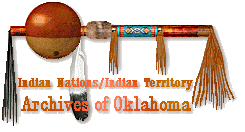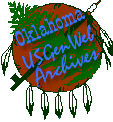Tulsa County
"Links
to web sites that are not part of the USGenWeb Project are provided for
your convenience
and do not imply any endorsement of the web sites or
their contents by The USGenWeb Project."


Indian Pioneer Papers - Index
Indian
Pioneer History Project for Oklahoma
Date:
December 3, 1937
Name:
John
L. Springston
Post
Office: Tulsa, Oklahoma
Residence
Address: 2747 East Fifth Street
Springston,
J.L.
INTERVIEW
12334.
Effie S. Jackson
Journalist
December 3, 1937
Interview with
J.L. Springston
2747 East Fifth
Street, Tulsa, Oklahoma
Of all the
material in his files on his life and times of his father, W.B.
Springston, Mr. J.L. Springston treasures most his father’s account of
the early day history of Spavinaw. Following is the story of that time
from the pen of John L. Springston and signed by him.
Spavinaw, as a
place of locality, was originally known as Lynch’s Mill, later taking
the name of Spavinau or Spavinaw. A sawmill was the first improvement
on the place and a gristmill was added soon afterward. Later a colony
of Mormons from the North came and took over the sawmill and gristmill.
They then put in a large mill building, two or three stories high and
also they put in a flour mill. That was the status of the place up to
the Civil War; it was known as Lynch’s Mill.
West and north of
the mill Thomas L. Rogers builded himself a house and it yet stands. It
was a two room log house, one story high. I see in the paper that it is
said to have been the home of one West, which is a mistake. It was the
home of Rogers during the improvement and building of the mill
properties.
Salt works were
opened south of the mill, at the foot of the mill that borders the town
of Spavinaw on the south. Both of these properties were operated under
the same management, until the war began in 1861.
Joseph M. Lynch,
the original owner of the mill and the salt works, resided five or six
miles north of the settlement on what was then and now known as Lynch’s
Prairie, near Grand River. He was one of the leading citizens of the
Cherokee Nation and one of the best lawyers. He had three boys, but I
recall the name of only two, Joe Jr. and Lon. Joe later lived in the
Canadian District of the Cherokee Nation and died there. Lon, after the
war, lived in Flint District and died there.
Joseph M. Lynch
was a slaveholder, and one of his slaves was Boson, the tanner. Lynch
had a tannery business until after the war. Mr. Lynch was a
tanner too. Mr. Lynch operated a large farm and was generally well to
do.
Between the Lynch
place and the mill lived a full-blood Cherokee Indian named Doo-Stoo,
or Spring Frog, a Baptist preacher who also owned a large farm and was
plentifully supplied with this world’s goods.
From Lynch’s home
due south two miles lived Mrs. Elizabeth Elliott, grandmother of the
writer. Lynch lived on the north side of the prairie and Mrs. Elliott
lived on the south. Just west of the Elliott house lived one Elliott
Towers.
West, a man
alluded to in a recent article, lived below the mill. Now he lives
about two miles down the creek. He owned and operated a large, fine
farm. His wife was named Mahala and his four children as I remember
them in order were Walter, Will, Laura and John.
About two miles
west of the West home lived Anderson Bangs and his wife Susan and two
children, James and Osceola. The latter now lives at or near Adair, on
the M.K.T. Railroad. West’s wife was a McLaughlin.
Directly north of the mill lived Hiram Landrum, head of one of the
prominent families of the Nation. Hiram Jr. after the Civil War
represented the Cherokee at Washington as national delegate. West of
Hiram there lived another Landrum, David. This home was east and north
of the present dam.
The WICKLIFFES.
East of the dam up the
Spavinaw Creek a mile or so, lived John Wickliffe, father of the boys
who were some years ago hunted as outlaws and who are now good citizens
of the county in which they live.
Just up the stream from the
Wickliffes there lived an Indian who had a sort of zoo. He owned
two black bears and kept them in a log house. They were the first
in captivity in the Western Cherokee Nation. He also had a parrot
which could not learn Cherokee, therefore, the parrot had to live
without talking.
Still on above the parrot
and bear house there lived one George Seven, full blood. Then
further up the creek was the largest farm on the creek owned by
Alexander Springston, father of the writer. One Sixkiller lived
yet above that place. There is only one of this family now
living, Moses Ridge, a Baptist minister near Salina.
DELAWARE TOWN.
The Anderson Springston farm
was about two miles above the dam. Two miles east of this place
was the place called Delaware Town, where the Osages were originally
located. The Delaware tribe ran them out of the locality and
located there themselves. Hence, the name of Delaware Town.
Before the Cherokees as a
Nation moved west, the Osages occupied the territory from Delaware
River to where Vinita is now located. They owned from Vinita down
the present line of the Katy Railroad to opposite Wagoner, from there
to Grand River across to Illinois River, across the Illinois River to
Lee’s Creek, now in Sequoyah County, opposite Fort Smith. The
drive against the Osages by the Cherokees began not long prior to 1838
and when the main body of the Cherokee emigrated west, the Osages were
obliged to leave the Cherokee land and go farther west for a
location. They encamped for awhile at Claremore but eventually
left the country.
THE NATIONAL
CHURCH
Delaware Town was
the seat of the Baptist Church, the largest in the Nation at that
time. It was sixty by sixty feet. The entire Nation
attended church there each year. In September the church was
surrounded with small kitchens and sleeping booths were prepared
especially for the women of the advanced class in education and wealth.
They were all taken care of during the progress of the services.
Evan Jones and his son, John
B. Jones were the founders and pastors. They were missionaries
and they did more for the uplifting and civilization of the Cherokees
than all other denominational workers of the period. But The Civil War
broke them down and effected the work they had given to the cause up to
the time of the war. Neither of the missionaries lived to renew
the work after the war, except for the establishment of the Bacone(?)
School, first at Tahlequah, later at Muskogee.
CHIEF DOWNING, A
PREACHER
At Delaware Town church,
especially in the month of September, every year, the people from all
over the Nation congregated. Lewis Downing, later principal chief
of the Nation, was one of the favorite ministers for these
occasions. Captain Spring Frog was also a leader.
Representatives of district churches throughout the nation attended
officially. Captain Thomas Pegg, one of the leading Cherokee
ministers, was a national representative of his people.
It is understood that Thomas
Rogers of Lynch’s Mill was the
brother of Charles Rogers of Coo-wee-scoo-wee district, Cherokee
Nation. It is said that Hon. C.V. Rogers, father of the noted
Will Rogers was also a brother. This is purely surmise with the
writer.
On the mountain region south
and west of the dam, as well as on the ridges south and east, were
deer, turkey and fox ranges prior to the war. They were then
plenty. During the fall and winter wild pigeons clouded the skies
by millions.
SURPHUR SPRINGS
Just northeast of the home
of the writer’s father, nine miles or so above the present dam, are two
great springs. One of them is sulphur and quite strong.
Prior to the Civil War it was the stomping ground of cattle and horses
from sections for miles around. This was particularly true during
the summer season. Up the creek from the sulphur spring about a
mile and a half there is a spring that bears the record of pure and
cool water in the summer and heated water in the winter. This
spring is located on the road that leads from the writer’s old home to
the school house he attended for eleven or twelve years.
Central Delaware district
was the home of Charles Thompson, chief of the Cherokees from 1875 to
1879. This was in the Charles Landrum settlement, eleven miles
east from the Delaware Town Baptist church. This was Spavinaw
Creek and the District Court house was located there at one time.
Three miles south from the
home of the writer was the home of
Ne-cow-ee Thompson, brother of Chief Charles Thompson. He was one
of the strongest friends the Indians ever had anywhere at any
time. His loyalty and activity developed during the Civil War and
this will be detailed later.
Some distance south of the
dam lived Lewis Ross, brother of the great chief of the
Cherokees. He had a fine home and extra large farm
holdings. He was a slave owner and he had great herds of cattle
and horses. His home was near Salina and debris is yet to be
seen. The place became the Cherokee orphan’s home and was burned
down several years ago.
Above is the story of what
was once Lynch’s Mill, later Spavinau now Spavinaw, and the location of
a great dam. This story also bears on the territory that was
Goingsnake, Delaware and Saline district of the Cherokee Nation, later
Indian Territory, now Oklahoma, once home of the original North
American Indians.
Written November 1, 1925 by
John L. Springston.
NOTE by transcriber
Garry R. Remington, July 14, 2006:
This story related by
Effie S. Jackson in 1937 was printed in the Tulsa Daily World, November
1, 1925. Since it is almost a word for word account it may stand
to reason she copied the newspaper story and it was provided her by
W.B. Springston. J.L. Springston died January 7, 1929.
This page was last updated on
07/21/08

God Bless America
Hosted & © 2026
by

OKGenWeb State
Coordinator
Linda
Simpson
Asst:
Mel Owings
|
©
1996-Present
~ OKGenWeb Coordinator ~ All Rights Reserved
NOTICE: In keeping with our policy of providing
free Information on the Internet, data may be used by
non-commercial entities, as long as this message remains on all
copied material. These electronic pages may NOT be reproduced in
any format for profit or for presentation by other persons or
organizations. Files may be printed or copied for Personal use
only. Persons or organizations desiring to use this material for
purposes other than stated above must obtain the written consent
of the file contributor. |









